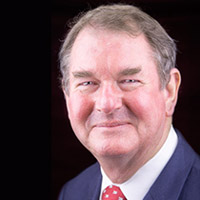Transferring Assets to a Second Spouse (and to children from the first)

Transferring Assets to a Second Spouse (and to children from the first)
Elizabeth and Thomas Carr (names fictitious), both in their late 60s, each have one child from a prior marriage. During the 30-plus years of their marriage, they each have accumulated an estate of over $5 million. The full $1.5 million credit against estate tax (for 2004) remains available to them. They are working on their estate plan and are concerned about how they can transfer the bulk of their assets to each other, minimize estate taxes and ensure that their children receive their fair share.
The Carrs currently each have in effect a Last Will and Testament that creates a trust (funded by the $1.5 million credit), with the balance left outright to the surviving spouse. Upon the death of that surviving spouse, the two children from the prior marriages will share the assets equally. These “mirror” wills were prepared at a time when the Carrs had assets that approximated the unified credit amount. The question that the Carrs have asked is: Does this type of plan need to be updated to accomplish the goals that Elizabeth and Thomas Carr have set? The answer is yes.
Some spousal bequest basics
Under federal tax laws a person may transfer all assets to a spouse and thereby avoid federal tax on the estate’s assets. The deduction available for assets passing to a surviving spouse applies not only to assets left under a Last Will and Testament, but also to assets not in the probate estate, such as retirement plan benefits, IRAs and life insurance. In fact, for married couples with joint assets at or below the credit amount, it is relatively simple to eliminate federal estate taxes. (State death taxes and federal income taxes still may apply.)
For the Carrs reducing estate taxes is more challenging. Although the unified credit and unlimited marital deduction will shield the estate of the first to die from federal estate taxes, under the Carrs’ present plan, a tax calamity will result upon the death of the second spouse. Why? The full value of both estates (less the amount that is carved out in a unified credit trust in each spouse’s estate) will be subject to federal estate tax. Once combined estates approach or exceed the amount that can be shielded by the unified credit, the goal is to reduce the amount that one spouse leaves to the second to die.
Use of QTIP trusts to reduce estate taxes and benefit children
One common way to reduce the tax in the estate of the second to die is through the use of a QTIP (Qualified Terminal Interest Property) created in a Last Will and Testament. A QTIP trust generally provides income for life to a surviving spouse, with the remainder (or trust principal) to pass according to the directions of the spouse who created it. In short, a surviving spouse is provided with the full economic benefit of the property held in trust (i.e., a full income interest in the assets held in trust and the right to invade principal in accordance with “ascertainable” standards, as defined in the tax code), yet the amount held in trust “bypasses,” or avoids, tax in the surviving spouse’s estate.
Special rules require that an executor affirmatively elect QTIP treatment on an estate tax return. QTIP trusts are quite popular for people with children from a prior marriage because income can be left to the surviving spouse for his or her life with the trust’s assets themselves later passing to the children of a first marriage. The good tax news is that a marital deduction for the full value (not just the value of the income interest) can be claimed in the estate of the first spouse to die. For the Carrs, who want to provide for each other, and for children of prior marriages, a QTIP trust is a good tool.
Other planning issues for “blended families”
Skillful estate planning may be needed for families that include children from prior marriages. This is particularly an issue for minor children, where guardianship and preservation of assets until attainment of majority are factors. However, even for the Carrs, whose children are grown, consideration should be given to the following:
If mirror wills are prepared, and both wills split assets among all surviving children, there may be no provision that prevents a surviving spouse from changing the will to provide that all assets go to his or her children only.
If the surviving spouse remarries, he or she may choose to disregard estate planning relative to the former spouse. Thought should be given to passing assets in a way that precludes a surviving spouse from changing the “plan.” This could include:
Creating living trusts or transferring assets at death into trusts that will provide for the children of a first marriage.
Naming children as beneficiaries of IRA or retirement plan assets.
Use of other nonprobate assets, such as life insurance policies, to provide benefits for children.
Review of legal documents in connection with prior divorces. These documents may affect rights and duties toward children of a first marriage, including, for example, maintenance of life insurance policies for the benefit of children or ex-spouses.
Points to keep in mind
Although plans are made for spouses to provide fairly for children from prior marriages, life is fluid, and so are estate plans. Upon the death of a spouse, circumstances may change for the survivor, and the plan may be inadequate or no longer suit the surviving spouse’s needs or situation. If these issues are raised during the planning process, it will facilitate each spouse’s goals of fair treatment for each other and all children. Family storms may lie ahead if the situation is not addressed honestly at the outset.
To receive our free newsletter, contact us here.
Subscribe to our YouTube Channel for more interviews and updates.
This transcript was generated by software and may not accurately reflect exactly what was said.

Alan Olsen, is the Host of the American Dreams Show and the Managing Partner of GROCO.com. GROCO is a premier family office and tax advisory firm located in the San Francisco Bay area serving clients all over the world.
Alan L. Olsen, CPA, Wikipedia Bio

GROCO.com is a proud sponsor of The American Dreams Show.

The American Dreams show was the brainchild of Alan Olsen, CPA, MBA. It was originally created to fill a specific need; often inexperienced entrepreneurs lacked basic information about raising capital and how to successfully start a business.
Alan sincerely wanted to respond to the many requests from aspiring entrepreneurs asking for the information and introductions they needed. But he had to find a way to help in which his venture capital clients and friends would not mind.
The American Dreams show became the solution, first as a radio show and now with YouTube videos as well. Always respectful of interview guest’s time, he’s able to give access to individuals information and inspiration previously inaccessible to the first-time entrepreneurs who need it most.
They can listen to venture capitalists and successful business people explain first-hand, how they got to where they are, how to start a company, how to overcome challenges, how they see the future evolving, opportunities, work-life balance and so much more.
American Dreams discusses many topics from some of the world’s most successful individuals about their secrets to life’s success. Topics from guest have included:
Creating purpose in life / Building a foundation for their life / Solving problems / Finding fulfillment through philanthropy and service / Becoming self-reliant / Enhancing effective leadership / Balancing family and work…

MyPaths.com (Also sponsored by GROCO) provides free access to content and world-class entrepreneurs, influencers and thought leaders’ personal success stories. To help you find your path in life to true, sustainable success & happiness. I’s mission statement:
In an increasingly complex and difficult world, we hope to help you find your personal path in life and build a strong foundation by learning how others found success and happiness. True and sustainable success and happiness are different for each one of us but possible, often despite significant challenges.
Our mission at MyPaths.com is to provide resources and firsthand accounts of how others found their paths in life, so you can do the same.
Todays China | Nicholas Hope
About Nicholas Hope Nicholas Hope is the Director of the Stanford Center for International Development (SCID). He also directs SCID’s China research program. His current research is private enterprise development in China and progress of reforms in China, especially in the financial sector. His interests are in East Asian economies, especially China and Indonesia,…
Why Are True Leaders Rare? | Jonathan Coslet
About Jonathan Coslet Jonathan Coslet has been with TPG Capital since it started in 1993. Currently he is the firm’s Chief Investment Officer and serves on TPG’s Executive Committee. Jonathan graduated Valedictorian from the Wharton School of Business where he received his Bachelor’s of Science in Economics and Finance. He received his MBA from…
Silicon Valley’s Bubble- What Happens When It Bursts? | Montgomery Kersten
About Montgomery (Monty) Kersten Montgomery Kersten serves development-stage companies as an independent board member, investor and advisor. Mr. Kersten was the co-founder & CEO of VitalSigns Software (later acquired), and serves as the independent board member of Silicon Valley private companies. He has worked for 35 years as an executive in sales, marketing, business…
Scott McNealy- What Projects I’m Currently Working On
About Scott McNealy- Silicon Valley Icon Scott McNealy co-founded Sun Microsystems, Inc.in 1982, serving as Chief Executive Officer and Board Chairman for over 22 years. During his tenure, McNealy transformed Sun from a Silicon Valley start-up to a leading provider of network computing. In October 2011, McNealy announced his next venture, Wayin. Wayin offers…




